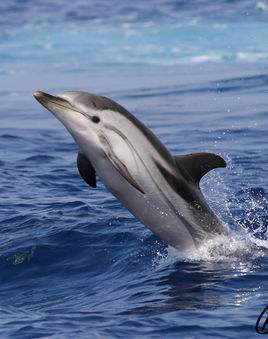
Delphinus capensis
Delphinus capensis,Long-beaked common dolphin, Common Dolphin,Toothed dolphin, tropical dolphin, long-beaked dolphin
Long-beaked common dolphin, with two subspecies, is a warm-water species.Lon···

Stenella clymene
Stenella clymene,Short-snouted Spinner Dolphin,Clementine's dolphin, helmeted dolphin, spotted dolphin
Short-snouted Spinner Dolphin, with no subspecies, is a deep-water species i···

Stenella coeruleoalba
Stenella coeruleoalba,Striped dolphin,Blue and white dolphin, blue and white dolphin, striped dolphin
Striped dolphin, with no subspecies, is a common dolphin in the Pacific Ocea···

Stenella attenuata
Stenella attenuata,Pantropical spotted dolphin,Tropical spotted dolphin, weak dolphin, white-beaked dolphin
Pantropical spotted dolphin, with two subspecies, may be the most common cet···

Steno bredanensis
Steno bredanensis,Rough-toothed dolphin,Long-beaked dolphin, wrinkled-toothed dolphin
Rough-toothed dolphin, a dolphin with special teeth.Rough-toothed dolphins u···

Platanista gangetica gangetica
Platanista gangetica gangetica,Ganges River Dolphin,White puffer fish, Goto puffer fish
The Ganges River Dolphin is a nominative subspecies of the South Asian river···

Lipotes vexillifer
Lipotes vexillifer,Baiji, Yangtze River Dolphin,Baiji,zhú (ancient name), Baiji, Chinese finless porpoise, Baiji dolphin
The scientific name of the Baiji dolphin is Lipotes vexillifer, and its fore···

Megaptera novaeangliae
Megaptera novaeangliae,Humpback whale,Humpback whale, humpback whale, saw-armed whale, saw-armed whale
Humpback whale is not the largest whale in the world, but it is also a well-···

Balaenoptera physalus
Balaenoptera physalus,Fin Whale,Finback whale, baleen whale, razorback whale, herring whale, fin whale
Fin whales are one of the fastest whales, with a speed of up to 37 kilometer···

Balaenoptera omurai
Balaenoptera omurai,Omura whale
Omura's whale is a medium-sized whale that looks very similar to a fin w···

Balaenoptera brydei
Balaenoptera brydei,Bryde's whale,Anchovy, Pseudomonas auratus
Bryde's whale, also known as Bryde's whale in English, has no subspe···

Balaenoptera borealis
Balaenoptera borealis,Sei whale, baleen whale, northern baleen whale, great baleen whale, cod whale
Sei whales are called Sei whales in foreign languages and have two subspecie···

Balaenoptera acutorostrata
Balaenoptera acutorostrata,Minke Whale、Common Minke Whale,Minke whale, Sharp-billed whale
Minke Whale has two subspecies and is a small baleen whale of the genus Myst···

Balaenoptera musculus
Balaenoptera musculus,Balaena musculus Linnaeus,Blue Whale, Baleine bleue,Ballena Azul,Blauwal, Razorback whale, Sulphur bottom whale, Sibud's whale, Seba's baleen whale, Great blue whale, G
The blue whale is called Blue Whale in English. There are 4 subspecies. It i···

Eschrichtius robustus
Eschrichtius robustus,gray whale,Whale killer, shell digger, weak whale
Gray whale is also known as gray whale in English. Its body circumference is···

Eubalaena japonica
Eubalaena japonica,North Pacific right whale, black right whale, black right whale
The North Pacific right whale has no subspecies.For a long time, cetaceans b···

Lepus yarkandensis
Lepus yarkandensis,Southern Xinjiang rabbit, Shache rabbit, hare
The Tarim rabbit is called Yarkandhare in English and is a typical desert sp···

Lepus timidus
Lepus timidus,Mountain hare,White rabbit, color-changing rabbit, blue rabbit
The snow hare is called Mountain hare in English, and there are 25 subspecie···

Ochotona argentata
Ochotona argentata,Ningxia pika
Helan Mountain Pika, also known as Ningxia Pika, English name Silver Pika, i···

Sciuridae
Sciuridae,Squirrel,Tree Rat
Squirrels, belonging to the family Sciuridae of the order Rodentia, refer to···

Castor
Castor,beaver
Beaver is called Eurasian Beaver in English, and there are 7 subspecies.Beav···
